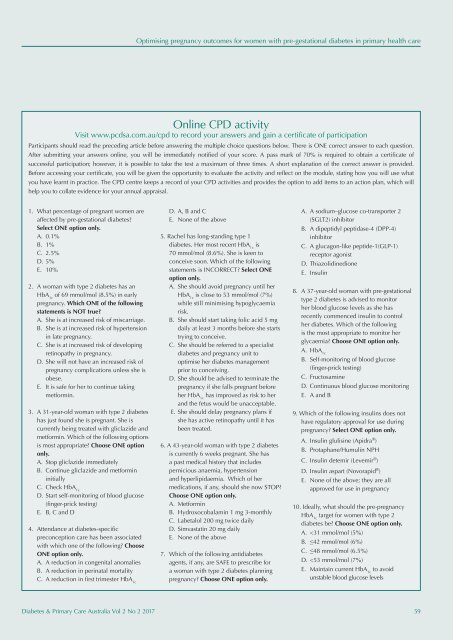DPCA2-2_issue_v3
You also want an ePaper? Increase the reach of your titles
YUMPU automatically turns print PDFs into web optimized ePapers that Google loves.
Optimising pregnancy outcomes for women with pre-gestational diabetes in primary health care<br />
Online CPD activity<br />
Visit www.pcdsa.com.au/cpd to record your answers and gain a certificate of participation<br />
Participants should read the preceding article before answering the multiple choice questions below. There is ONE correct answer to each question.<br />
After submitting your answers online, you will be immediately notified of your score. A pass mark of 70% is required to obtain a certificate of<br />
successful participation; however, it is possible to take the test a maximum of three times. A short explanation of the correct answer is provided.<br />
Before accessing your certificate, you will be given the opportunity to evaluate the activity and reflect on the module, stating how you will use what<br />
you have learnt in practice. The CPD centre keeps a record of your CPD activities and provides the option to add items to an action plan, which will<br />
help you to collate evidence for your annual appraisal.<br />
1. What percentage of pregnant women are<br />
affected by pre-gestational diabetes?<br />
Select ONE option only.<br />
A. 0.1%<br />
B. 1%<br />
C. 2.5%<br />
D. 5%<br />
E. 10%<br />
2. A woman with type 2 diabetes has an<br />
HbA 1c<br />
of 69 mmol/mol (8.5%) in early<br />
pregnancy. Which ONE of the following<br />
statements is NOT true?<br />
A. She is at increased risk of miscarriage.<br />
B. She is at increased risk of hypertension<br />
in late pregnancy.<br />
C. She is at increased risk of developing<br />
retinopathy in pregnancy.<br />
D. She will not have an increased risk of<br />
pregnancy complications unless she is<br />
obese.<br />
E. It is safe for her to continue taking<br />
metformin.<br />
3. A 31-year-old woman with type 2 diabetes<br />
has just found she is pregnant. She is<br />
currently being treated with gliclazide and<br />
metformin. Which of the following options<br />
is most appropriate? Choose ONE option<br />
only.<br />
A. Stop gliclazide immediately<br />
B. Continue gliclazide and metformin<br />
initially<br />
C. Check HbA 1c<br />
D. Start self-monitoring of blood glucose<br />
(finger-prick testing)<br />
E. B, C and D<br />
4. Attendance at diabetes-specific<br />
preconception care has been associated<br />
with which one of the following? Choose<br />
ONE option only.<br />
A. A reduction in congenital anomalies<br />
B. A reduction in perinatal mortality<br />
C. A reduction in first trimester HbA 1c<br />
D. A, B and C<br />
E. None of the above<br />
5. Rachel has long-standing type 1<br />
diabetes. Her most recent HbA 1c<br />
is<br />
70 mmol/mol (8.6%). She is keen to<br />
conceive soon. Which of the following<br />
statements is INCORRECT? Select ONE<br />
option only.<br />
A. She should avoid pregnancy until her<br />
HbA 1c<br />
is close to 53 mmol/mol (7%)<br />
while still minimising hypoglycaemia<br />
risk.<br />
B. She should start taking folic acid 5 mg<br />
daily at least 3 months before she starts<br />
trying to conceive.<br />
C. She should be referred to a specialist<br />
diabetes and pregnancy unit to<br />
optimise her diabetes management<br />
prior to conceiving.<br />
D. She should be advised to terminate the<br />
pregnancy if she falls pregnant before<br />
her HbA 1c<br />
has improved as risk to her<br />
and the fetus would be unacceptable.<br />
E. She should delay pregnancy plans if<br />
she has active retinopathy until it has<br />
been treated.<br />
6. A 43-year-old woman with type 2 diabetes<br />
is currently 6 weeks pregnant. She has<br />
a past medical history that includes<br />
pernicious anaemia, hypertension<br />
and hyperlipidaemia. Which of her<br />
medications, if any, should she now STOP?<br />
Choose ONE option only.<br />
A. Metformin<br />
B. Hydroxocobalamin 1 mg 3-monthly<br />
C. Labetalol 200 mg twice daily<br />
D. Simvastatin 20 mg daily<br />
E. None of the above<br />
7. Which of the following antidiabetes<br />
agents, if any, are SAFE to prescribe for<br />
a woman with type 2 diabetes planning<br />
pregnancy? Choose ONE option only.<br />
A. A sodium–glucose co-transporter 2<br />
(SGLT2) inhibitor<br />
B. A dipeptidyl peptidase-4 (DPP-4)<br />
inhibitor<br />
C. A glucagon-like peptide-1(GLP-1)<br />
receptor agonist<br />
D. Thiazolidinedione<br />
E. Insulin<br />
8. A 37-year-old woman with pre-gestational<br />
type 2 diabetes is advised to monitor<br />
her blood glucose levels as she has<br />
recently commenced insulin to control<br />
her diabetes. Which of the following<br />
is the most appropriate to monitor her<br />
glycaemia? Choose ONE option only.<br />
A. HbA 1c<br />
B. Self-monitoring of blood glucose<br />
(finger-prick testing)<br />
C. Fructosamine<br />
D. Continuous blood glucose monitoring<br />
E. A and B<br />
9. Which of the following insulins does not<br />
have regulatory approval for use during<br />
pregnancy? Select ONE option only.<br />
A. Insulin glulisine (Apidra ® )<br />
B. Protaphane/Humulin NPH<br />
C. Insulin detemir (Levemir ® )<br />
D. Insulin aspart (Novorapid ® )<br />
E. None of the above; they are all<br />
approved for use in pregnancy<br />
10. Ideally, what should the pre-pregnancy<br />
HbA 1c<br />
target for women with type 2<br />
diabetes be? Choose ONE option only.<br />
A.
















